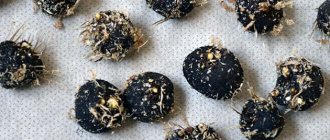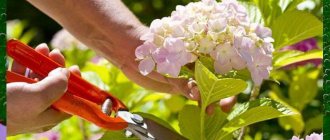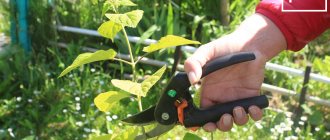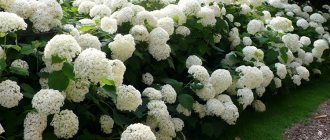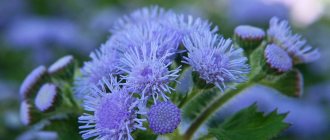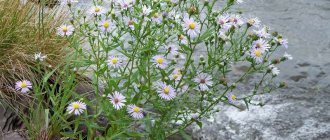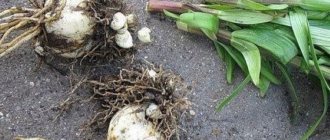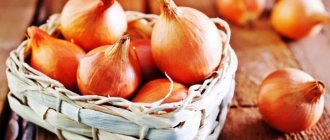A person who has ever seen a hydrangea in bloom will be delighted and may even decide to plant it in his dacha or in front of his house. Different types of hydrangea (lush shrub, tree or vine) will decorate any garden. You can grow perennials even in shaded areas.
Experienced gardeners warn that the plant is demanding. In order for it to take root, you must first choose the right place and then carry out planting work. In addition, hydrangea care should also be decent, especially in the first year of life of the now fashionable flowering bush.
Planting hydrangea in spring in open ground
Garden hydrangea: planting in open ground
Before planting a crop, it is necessary to evaluate the pros and cons, as well as analyze the climatic conditions and soil quality. The shrub grows well only in certain conditions, and does not please its owners with flowers in dry, sunny latitudes. The rhizome of this plant grows widely and requires space.
Garden hydrangea, planting in open ground:
- You cannot plant shrubs near bushes and plants whose roots require a lot of space. Please note that this is a moisture-loving crop, so it needs to be watered frequently. It is best to place the crop in places where it is possible to control the humidity level. That is why such plants are planted near ponds, or mulch is constantly added, which helps retain moisture near the roots.
- Water stagnation should not be allowed, as this will contribute to root rot. It is necessary that the place where the hydrangea grows is well lit, but there is no access to direct sunlight. It is best to place it in areas with diffuse sunlight or slightly shaded areas. It is worth placing the plant nearby near the house or gazebo, which is located near the river.
Bushes
Features of hydrangea
In the wild, hydrangea is represented by three-meter shrubs, not very large trees, as well as vines that can climb tree trunks to a height of thirty meters. Also, such hydrangeas can be deciduous or evergreen (depending on the type). In mid-latitudes, deciduous species are most preferred to grow. Most often, such a plant has oppositely arranged leaves of large size; they are oval in shape with a point at the top. The edge of the leaf blades is most often jagged, and veining is clearly visible on their surface. Hydrangea begins to bloom in the spring, and ends only after the onset of frost in the fall. The flowers are collected in large inflorescences, which can have a corymbose, spherical or paniculate shape. The inflorescences include 2 types of flowers. Some of them are small fertile (fertile), located, as a rule, in the middle part of the inflorescence, while others are large sterile (sterile), which are located along the edge of the inflorescence. There are species that have only one fertile flower. Most hydrangeas have white flowers. However, there are species, for example, large-leaved or large-leaved hydrangea, which can have flowers of various colors: cream, white, blue, pink, red and lilac. It is interesting that the exact color of the flower is influenced by the pH value of the soil. So, for example, if the substrate is neutral, then the flowers will be cream or beige, if alkaline, then pink or lilac, and if the substrate is acidic, blue, because the soil contains aluminum, which is easily absorbed by hydrangea. The fruit of this flower is a capsule with 2–5 chambers, which contains small seeds. It happens that a flower belonging to the close genus Schizophragma is mistakenly called hydrangea, but you should know that petiolate hydrangea is nothing more than a schizophragma.
When can you plant hydrangea in open ground?
The time of year when it is necessary to plant hydrangea in the soil depends on the climatic conditions of the area.
When can you plant hydrangea in open ground:
- It is best to plant in early spring, but this is appropriate in temperate regions where the soil warms up very quickly. In April, in central Russia, you can safely plant hydrangea.
- If you live in the northern regions, then it is best to wait a little and start planting the crop in May to avoid frost. At the initial stage, immediately after planting, the crop is sensitive to temperature changes and frosts.
- Some gardeners recommend planting in the fall, which is only appropriate if the region has a mild climate and fairly warm winters. Experts recommend planting hydrangea in the fall in the southern regions, near the sea. That is, this is the Krasnodar region. In other regions, in central Russia, it is best to plant in May or early June, when the threat of frost has completely passed.
Hydrangea
Suitable timing
It is best to divide a hydrangea bush in early spring, before the juices begin to flow. If for some reason the deadlines were missed, propagation of hydrangea by division can be postponed until the beginning of autumn. Summer residents of the northern regions will have to postpone the procedure until next spring.
This is not recommended during high season for two reasons. Firstly, hydrangea blooms most of the summer; the bush spends a lot of energy on flowering, which means dividing and replanting will result in severe stress for the plant. Secondly, if the bush is disturbed during the active growing season, the divisions will hurt for a long time and may not take root.
How to properly plant hydrangea in open ground?
Gardeners recommend planting the crop in the eastern sides, where there is sun early in the morning, and partial shade in the afternoon and at noon. These are ideal conditions for growing crops. It is necessary that the soil is drained, with an acidity no higher than 6. The ideal soil pH level is from 5.2 to 6.0. This is a slightly acidic environment in which the crop grows best. On alkaline soils, the plant quickly turns yellow and falls off, gives a very weak color and does not please the owner.
How to properly plant hydrangea in open ground:
- To plant, you need to dig a hole, the size of which should be approximately 50 by 50 cm. The depth of the hole should correspond to its width and length. If these are large varieties, then the pit should be larger. Its dimensions are 80 by 80 centimeters.
- Please note that before planting it is necessary to add fertilizer to the hole. It is necessary to pour the fertilizer into the prepared hole and fill it with three buckets of water. The indentation is left overnight. Thus, the soil will be well saturated with moisture, and the fertilizer will be absorbed into it.
- In the morning, you should add a nutrient mixture to the hole, which consists of soil, peat, humus and sand. The ratio should be 2:2:1:1. Sometimes it is recommended to add organic fertilizers along with mineral fertilizers. The ideal option would be a mixture of 25 g of urea, potassium sulfate and 65 g of superphosphate. Often, to increase the acidity of the soil, pine needles are used, which are poured into the hole.
Garden hydrangea
Proper fertilizer when planting
Suitable soil is rare, but it can be adapted so that the hydrangea takes root and begins to grow immediately. For drainage, sand or broken bricks are poured into the bottom of the hole.
The remaining volume is filled with a substrate of excavated soil, humus and high-moor peat. This composition will allow you to grow hydrangea even in a clayey place with poor soil. Recommended proportions: 2 parts each of turf soil and humus and 1 part each of clean sand and peat.
Before planting the seedling, the earthen ball should be lightly shaken off so that the roots straighten and grow faster. The plant goes deep into the prepared nutrient “cocktail” to the level of the root collar.
Planting hydrangea: distance between bushes
Many gardeners are interested in the question of how much distance should be left between hydrangea bushes during planting.
Planting hydrangea, distance between bushes:
- If it is a large-leaf crop, then the distance should be approximately 1.5 m.
- If this is a paniculate crop, then it is worth increasing the distance to 2.5 m.
- The bushes grow strongly and give lush color.
- Remember, if you are decorating a flower bed, it is best to maintain a distance of 3 m from planting other crops.
Near the house
Protection from pests and diseases
For 2-3 years after planting, hydrangea bushes do not require pruning, and the substrate rich in nutrients is enough for the full development of the plant. But the flower may suffer from pests.
Wet soil promotes the development of rot and fungal diseases. If a whitish coating, rusty spots or causeless wilting of foliage appears, you need to remove all damaged parts and treat the hydrangea with a fungicide.
Insecticides help against pests. To combat diseases due to improper care, adjustments are made: hard water is replaced, the amount of fertilizer is reduced.
How to plant hydrangea in open ground in summer?
You can plant hydrangea in the summer, which is recommended for plants with a closed root system. The main disadvantage is that a plant planted in summer requires more care than one planted in spring or autumn.
How to plant hydrangea in open ground in summer:
- The ideal time for planting is the first half of June. Don't expect any flowers to appear the first year. The first flowering will begin around the third year. If flower stalks form ahead of time, they must be cut off.
- This is necessary to strengthen the root system, stimulate the growth of the green part, and also improve the condition of the plant as a whole. After all, flowers significantly weaken the crop and can make it weak, which will lead to its death. In the summer, it is necessary to dig a hole with dimensions of 50 by 50 cm.
- It is better to make a recess in advance, about three weeks before planting. Add peat, soil, humus, and sand into the recess in a ratio of 2:2:1:1. It is necessary to install the seedlings in the recess, straighten the roots so as not to damage them. Cover the roots with soil and compact lightly.
- Be sure to pour in three buckets of water and mulch the soil. This will keep moisture inside. Under no circumstances should hydrangea be planted during flowering; such crops do not take root well. If there is such a need, you need to cut off the flower stalks and only then plant. Then the bush will take root well and will not waste energy on flowers.
Beautiful flowers
Problems during cultivation
If the plant exhibits poor growth, insufficient or absent flowering, it is necessary to check the light level, amount of watering, and condition of the roots (hilling deeper than 10 cm is prohibited). It is too early to judge if the hydrangea was just transplanted.
Why does pink hydrangea bloom white? For pink hydrangea, soil acidity is important - the permissible level is 6.5 pH (neutral). Under the bush you can add a little crushed chalk or lime, soil with a neutral acidity level. If the soil was alkaline, the color will become normal.
Typical diseases and pests
Diseases manifest themselves from poor conditions - sunburn, excess or lack of watering, disturbed mineral balance. Main diseases:
- chlorosis (lack of iron, oversaturation of lime);
- spots (white, from burns);
- dry blackening leaves (excess sun, high water hardness);
- wet dark leaves (from spraying herbicide fertilizers).
Fungal rot (white, gray), peronosporosis, powdery mildew and others are also possible. Hydrangea pests are standard garden pests (aphids, spider mites, root-knot nematodes, slugs).
If the disease is diagnosed, fungicides are used. If pests have attacked or parasites have settled on the bushes, you will have to buy insecticides.
How is hydrangea planted in open ground in spring?
The ideal time to plant hydrangeas is spring. This time of year is most suitable for central Russia and its northern part. The best time is the end of April or the beginning of May. The landing sequence is slightly different. It is necessary to dig a hole with dimensions of 50 x 50 cm, add a mixture of soil, humus, peat and sand. During this period, a crop with an open root system is planted.
How to plant hydrangeas in open ground in spring:
- It is worth planting a plant with an open root system not in a depression, but by forming a hill from the nutrient mixture. The mixture is prepared from soil, peat, humus, and sand. It is necessary to form a small hill from the mass, place the plant on top, straighten the root system and sprinkle with soil.
- This must be done in such a way that the root collar is visible from the ground, about 4 cm. The elevation and partial exposure of the neck prevents the occurrence of rotting. In order for the plant to hold well, it must be compacted and watered with three buckets of water.
Near the house
Preparing the soil and planting hole
All hydrangeas prefer acidic soil. The optimal acidity level for them is 5 pH. When preparing the soil for a planting pit, you cannot use components such as dolomite flour, lime, or wood ash. The best soil mixture for hydrangeas would be the following:
- 2 hours of garden soil;
- 2 hours of humus;
- 1 hour high peat;
- 1 tsp coarse sand.
Sheltering hydrangeas for the winter
The optimal size of the planting hole for each division is 50x50x50 cm. Holes should be dug at such a distance that each bush can develop freely in the future.
How to plant hydrangea in open ground in the fall?
In autumn, hydrangea is planted only if it has a well-developed root system. The maturity of the roots will protect the plant from freezing and speed up its adaptation to the new location.
How to plant hydrangea in open ground in the fall:
- For midland regions, it is better to choose September. If this is the southern part of Russia, you can perform manipulations in October. A hole measuring 50 by 50 cm is dug into which the soil mixture is added. Approximately 20 liters of water should be poured into the hole.
- During this period, it is best to plant plants by transshipment, so as not to damage the roots even slightly. To do this, the soil in the pot is pre-moistened and the bush is carefully removed along with a lump of soil.
- Next, you need to plant the plant and fill it with nutritious soil mixture. You need to leave about 3-4 cm so that the root collar does not rot. Water thoroughly, and only then apply mulch. It could be peat or pine needles. Please note that for maintenance it is necessary to constantly moisten the soil and mulch the soil in a timely manner.
Beautiful flowers
Types of hydrangea photos and names
If you are thinking about decorating your garden with hydrangea, then first of all you should pay attention to the characteristics of the different types of this plant. Then you can choose exactly those species that will be best suited for your garden. It is also important to know how to care for each species. For example, tree or large-leaved hydrangea must be prepared for wintering and pruned somewhat differently than paniculate hydrangea. If you know a lot about the rules for caring for such plants, then caring for them will not be difficult.
Tree hydrangea (Hydrangea arborescens)
This variety is very popular among gardeners living in mid-latitudes. This plant is presented in the form of a shrub. Its height can vary from 100 to 300 centimeters. Inflorescences grow on the tips of annual stems. When the flowers just begin to open, they are light green in color; after they are fully opened, they change their color to cream or white. The most popular varieties are: “Invisible Spirit” - the flowers are pink; “Sterilis” - the inflorescences are painted white, and this plant blooms very profusely; "Annabelle" and "Grandiflora" - have very large inflorescences, painted pure white (note that paniculate hydrangea has varieties with exactly the same names).
Hydrangea paniculata
Under natural conditions, such a plant has the form of a tree or shrub, the height of which can vary from 2 to 5 m. This species is considered one of the most popular among gardeners. Without replanting in the same place, this type of hydrangea can grow and develop normally for more than 40 years. The stems of this plant become lignified in a relatively short time, which is why it is considered winter-hardy. Inflorescences grow in the upper parts of this year's stems, and the flowering is notable for its abundance. However, the buds formed in the last days of June open only in August or September. The inflorescences of this type of flower have a pyramidal shape. When the flowers begin to open, they are pale green in color, and after full opening they turn white. At the end of the summer they turn light pink and then brick. When the flowering period begins to end, the flowers turn light green again. The most popular varieties are Grandiflora, Quishu, Vanilla Fraze and Tardiva.
Large leaf hydrangea (Hydrangea macrophylla)
Or garden - it is often cultivated in the garden. However, some varieties can be grown in containers indoors or on the terrace. The dense leaves have a rich green color. This year's stems are herbaceous, which is why the bush does not have very high cold resistance. It is believed that the inflorescences appear on last year’s stems, since the buds for their growth are laid in the autumn, and they begin to grow in the spring. As a rule, the inflorescences have a viburnum-shaped, umbrella-shaped form; it is also called hemispherical or Japanese. The color of the flowers depends on the pH of the soil. More recently, interesting varieties have appeared: “Endless Summer” - in acidic soil - blue color, in neutral - lilac; "Renata Stanger" - blue; “Expression” and “Romance” have double flowers.
Oakleaf hydrangea (Hydrangea quercifolia)
It has low frost resistance and needs good insulation for the winter. It blooms very luxuriantly and has unusually attractive leaves. It has a height of about 2 m. The length of the paniculate inflorescences is from 10 to 30 centimeters. Flowering begins in June–July, with the flowers initially white and later turning purple.
Ground cover hydrangea (Hydrangea heteromalla)
Or hydrangea variegated - a winter-hardy species. Under natural conditions, the height can reach 200–300 centimeters. Often used to form a standard form. The length of dark green leaves is about 20 centimeters. The front side is smooth, and the back side is pubescent. The loose, corymbose-shaped inflorescences are initially white, and then turn pink at the end of flowering. Flowering begins in the last days of June or the first days of July. The most popular ground cover variety is Bretschneider, which blooms profusely in rather large inflorescences of a milky white color.
Gardeners also grow hydrangeas: ashen, serrated, radiant, rough, Sargent. They also grow the climbing species petiolate hydrangea, but as mentioned above, this is not a hydrangea.
Hydrangea: types, varieties
Planting hydrangea seedlings in open ground in spring: reviews
The plant needs pruning and preparation for the winter. This is a moisture-loving crop that does not tolerate heat. Hot areas with strong sunlight are not suitable for the plant. One watering requires spending approximately 25 liters of water. During the hot season, watering is carried out every week. The amount of liquid must be at least 20 liters.
Planting hydrangea seedlings in open ground in spring, reviews
Elena. I purchased a private house 5 years ago. It was not a very successful purchase, since the budget was limited. As a result, we had to work a lot to put the house in order and the small area around it. Three years ago I was landscaping the area and purchased several bushes. A neighbor decided to help me and gave me a small hydrangea seedling. I live in central Russia and did the landing in May. It was quite hot, so the plant began to wither and the leaves drooped. I had to install a small awning in this place, as well as arrange a recreation area. This created a shadow, and the hydrangea quickly came to its senses. To speed up adaptation in a new place, I watered it every week and applied fertilizer. The soil in my area is alkaline, I constantly have to increase its acidity. For this I use spruce needles and fertilizers.
Veronica . I’m not a big fan of gardening, but to get shade in the dacha, I planted hydrangea. This was not the best choice on my part, the plant does not like heat and needs to be watered often. There are no problems with water in the dacha community; I have my own well, but I don’t go to the dacha often. That is why we had to install drip irrigation to constantly moisten the soil. I mulched the area near the hydrangea with straw. It grows well, but produces small flowers. I think that the place is not the most suitable for her. I plan to buy a few more shrubs, but not hydrangeas, but hardy crops that respond well to direct sunlight.
Victor. I planted hydrangea at the dacha near our house 3 years ago. It grows well, I don’t experience any problems with it. I did everything according to the rules, specially preparing the mixture for good drainage. I water it often, last year it produced a lot of flowers and grew wider.
Near the house
A lot of interesting information about growing strawberries can be found on our website:
How to distinguish a female strawberry bush from a male one: the purpose of the definition, proper thinning of the bushes - tips for summer residents and gardeners
Lunar sowing calendar for gardeners and gardeners for 2020 in Ukraine - favorable days for sowing seeds, planting seedlings in the ground
The benefits of strawberries for children. At what age can you give your child strawberries?
Diseases of strawberries and garden strawberries, description of diseases, how strawberry diseases affect leaves and berries, treatment with chemicals and folk remedies
Growing strawberries and wild strawberries in PVC pipes vertically and horizontally with soil
It is worth using nutritious soil with high acidity. Therefore, if there are crops growing on the site that love alkaline soil, in no case rush to fertilize the hydrangea with ash or dolomite flour. After all, these fertilizers help reduce acidity and increase the alkalinity of the soil. The roots are located near the surface and grow sideways.
Reproduction
The easiest way is to buy seedlings in special receivers. The disadvantages are the cost, lack of the desired variety. Hydrangea can be propagated independently using the following methods.
Growing from seeds
The seeds of the plant do not require pre-treatment; they are immediately planted in pots (boxes, etc.). The soil is moistened, the seeds are not buried, covered with film or glass. The first shoots appear on average after three weeks.
Cuttings
The optimal way to propagate pink hydrangea is by cuttings. The time of bud formation (mid-July) is considered suitable. They use a green cutting - part of the stem with leaves and buds.
Attention! Cuttings are cut only from young bushes. If there are “old” plants on the site, “rejuvenating” pruning is first carried out.
Cuttings of hydrangea at home
Dividing the bush
This method is used only during plant transplantation. It is permissible to separate bushes of all types of hydrangea (except paniculata).
Period - spring (with the onset of warmth, but before flowering begins). First, water the bush well, then dig it up. The roots are washed from the ground and separated.
By layering
The method is used in early spring, before bud formation. Stages of work:
- Hill up the bush and level the ground.
- Create radial furrows, no more than 2 cm deep.
- Place one stem in each, sprinkle, but leave the top on the surface.
Attention! To prevent the stems from “popping out,” they are sprinkled with earth or pinned with wooden cuttings. During the summer, the sprinkled shoots are watered, achieving light soil moisture.
Care after landing
You cannot plant new hydrangea specimens and forget about them. In order for the divisions to take root, they need to be looked after. In the first two weeks, regular watering is needed to keep the soil moist. Translated from Latin, hydrangea (hydrangea) sounds like “a vessel with water”; the plant loves moisture very much. In rainy weather there is no need to water the bushes.
Feeding the bushes during autumn planting is not needed. Fertilizer application can be delayed until spring. It is advisable to mulch the soil with pine needles or the bark of coniferous plants. If the weather is hot and sunny, plants are protected from the sun with protective screens. Rooting of the cuttings will take about a month.
Fragrant bushes made from several branches of Hydrangea brought from vacation
Propagation of hydrangea by dividing the bush is also popular because in this case new specimens completely retain the varietal characteristics. For the winter, young bushes are covered with spruce branches or fallen leaves, and then fallen snow is thrown over them. Next spring the shrub will begin to grow actively, and in summer it will delight you with luxurious caps of inflorescences.
